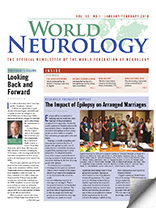By A. Buguet, P. Spencer, and J. Reis for the Environmental Neurology Research Group.
The Second International Meeting on Environmental Health Strasbourg (RISE 2017) was held Nov. 29-Dec. 1, 2017, at the Council of Europe in Strasbourg, France. The conference welcomed WFN President Prof. Raad Shakir and WFN General Secretary Prof. Wolfgang Grisold. As in 2016, the 2017 conference tackled the unresolved mechanisms and effects of air pollution and other environmental exposures on the brain and nervous system.

Pollutants in the air take many forms, including gases, fumes, liquid droplets, and solid particulate matter of various sizes. Inhaled fine and ultra-fine particulate matter can enter the lungs, cross the alveolar wall, enter the blood stream, and reach neural tissue either directly (circumventricular organs, sensory, and autonomic ganglia) or after passage across the blood-brain/nerve barriers.
An alternative route to the brain is from the nose and across the ethmoid wall to reach the olfactory pathway, whereupon particles can be transported retrogradely to cerebral structures. Particles that are swallowed may traverse the gut wall and enter the blood stream. Particulates that enter neural tissue trigger oxidative stress, neuroinflammation, and cellular damage.
Relapses in multiple sclerosis are linked to ambient air pollution. Whether chemical pollutants can trigger disease-inducing expression of latent neurotropic viruses is an unexplored question.
Chronic Exposure
Speakers emphasized that chronic exposure to polluted ambient air has important links with neurological disease during development, childhood, adult life, and advanced age. Specific chemicals and mixtures used in industry or to induce euphoria are established causes of peripheral neuropathy and cognitive deficits in children and adults. Chronic exposure to polluted air is an accepted risk factor for ischemic stroke, probably via a cardiovascular mechanism.
There are major concerns that air pollution increases the risk for disorders of neurodevelopment and brain maturation, resulting perhaps from epigenetic changes that may also have consequences for neurological health in later life and old age. Persistent epigenetic changes (DNA methylation) may be induced by naturally occurring substances, such as methyl donors in nutritional foods and manmade chemicals that become environmental pollutants.
Genetic, prenatal, and environmental risk factors have been linked to neuroendocrine disturbances during pregnancy (for example, thyroid gland and hormones) resulting in autism spectrum disorders, the incidence of which has increased and now affect males more than females (3:1).
Neurodegenerative Disease Links
Food and medicinal use of plants containing a potent methylating agent chemically related to substances found worldwide in preserved food and cigarette smoke (e.g. nitrosamines) has been linked to the prototypical neurodegenerative disease Western Pacific ALS-Parkinson Dementia Complex.
Tobacco use is a risk factor for Alzheimer’s disease and ALS, but not for Parkinson disease, possibly because nicotine is protective of dopaminergic neurons. High-incidence apparently sporadic ALS has been found in a village in the French Alps.
We were honored to receive lectures from both Prof. Shakir and Prof. Y. Le Maho, member of the Académie des Sciences (Paris).
Prof. Shakir pointed out recent changes in the field of neurology. He underlined the recent decision by the World Health Organization (WHO) regarding the previous misclassification of stroke, the second cause of death globally, and other neurological diseases. (At last, the WHO has recognized the pertinence of the WFN’s factual position: a tremendous achievement!)
Biodiversity
Prof. Le Maho, who had been invited to broaden the scope of the conference, lectured on biodiversity. Apart from nutrition, biodiversity renders multiple services to man. It is the source of medical and therapeutic innovations, and of information on restorative processes, on the control of scavengers and pests, on soft chemistry for the development and fabrication of new materials, and even on the use of plants to reduce pollution and increase air quality. The impact of global warming on biodiversity further weakens species endangered by human activities.
One of the main lessons is that human impacts on the environment are irreversible. We should learn from biology when addressing environmental impacts on the brain.
